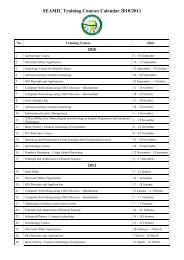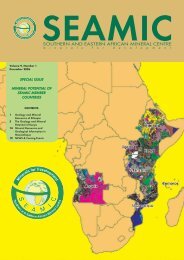SEAMIC Newsletter Vol. 10
SEAMIC Newsletter Vol. 10
SEAMIC Newsletter Vol. 10
Create successful ePaper yourself
Turn your PDF publications into a flip-book with our unique Google optimized e-Paper software.
Musoma-Mara greenstone belt: The Buhemba Mine produced 12.4 tons of gold and ranked<br />
second after Geita in 1960s. Rocks of Nyanzian Supergroup host the gold mineralisation and<br />
comprise a sequence of basic and felsic volcanics and tuffs with BIF. The Kiabakari, another old<br />
mine, is tabular, siliceous, with steeply dipping ore bodies in sericitic schist, overlain by laterite.<br />
It has been mined to a depth of 450m. The main ore body has a grade of 6.7g/t and is under<br />
exploration. The mine was once the third largest gold producer in Tanzania.<br />
The Afrika Mashariki Mine (Nyabirama and Nyabigena) in North Mara, is a mine under<br />
production with an ore resource of 4.1 M oz gold. The deposit, hosted in andesites and<br />
andesitic tuffs occurs along shear zones. Other deposits include Ikungu, Mrangi, Simba Sirori,<br />
Nyanisero, Nyasirori and Golden Glory.<br />
Nzega greenstone belt: Greenstones of the Nyanzian Supergroup comprise felsic volcanics,<br />
BIF, and subordinate mafic volcanics and sedimentary rocks. Mineralisation is hosted by BIF<br />
or felsic tuffs.<br />
Golden Pride gold deposit: This mine has a resource of over 2.8 M oz at a grade of 2.6 g/t.<br />
Mineralisation is hosted within an east-west striking, steeply dipping, brittle-ductile shear zone<br />
within a sequency of volcaniclastic and siliclastic rocks of Archean age. Lithologies dip steeply<br />
to the north and south. The shear zone mineralization extends over 14 km. Other mines<br />
include: Canuck mine and Matinje mine.<br />
Iramba-Sekenke greenstone belt: Greenstone-belt gold prospects occur over a broad area<br />
concentrated around the Iramba Plateau. The Sekenke Gold Mine was discovered in 1907 and<br />
worked at an average grade of 15.4 g/t gold and 2.5 g/t silver. Several parallel quartz veins<br />
contain gold values close to the contact between greenstones and diorite. Other old mines in<br />
the belt include Kirondatal, Union Gold Mine, Kinyalele, and Kisamamba.<br />
Lupa gold field: The Lupa Gold Field is underlain by a block of deformed and highly<br />
metamorphosed schists and gneisses with intermixed BIF, volcanics and granitic intrusions.<br />
The belt differs from the Lake Victoria goldfield in being hosted by metamorphic rocks of<br />
predominantly Proterozoic age rather than Archean. Gold is associated with quartz reefs<br />
emplaced in shear zones. Alluvial and eluvial gold deposits are not uncommon. The known gold<br />
deposits with past mining record in the area are: New Saza, Gap, Nkutano, Ruth, Maperi,<br />
Razorback, Ntumbi reef, Andura, Chisu, Kasanga bridge and Kizumbe. Placer gold used to be<br />
mined at Chapa, Zira and Matundas. Currently, few exploration companies are in the area<br />
trying to locate mineable gold deposits. Small-scale gold miners are producing limited amount<br />
of gold.<br />
Mpanda gold field: This belt is underlain mainly by rocks of Paleoproterozoic age though some<br />
Archean dates have been reported. The known deposits are: The Mukwamba old base metal<br />
mine (essentially a 0.1-1% copper, 1-3% lead, 1.5 g/t gold and 50-200g/t silver deposit).<br />
Mineralisation is confined to a shear zone in chlorite-sericite schist. In general the veins consist<br />
of banded quartz with variable amounts of siderite, calcite, barite, sericite, hematite, pyrite,<br />
galena, chalcopyrite and gold. Other deposits in the area include, Magamba Reef, D-Reef,<br />
Sikitiko Kapapa and Katuma.<br />
Copper, cobalt and associated minerals<br />
Base-metal occurrences have been found in Archean and Proterozoic rocks of Tanzania. A<br />
world class Kapalagulu platinum-copper-nickel prospect is now under extensive exploration.<br />
The Kabanga nickel-cobalt-copper is another world class deposit on advanced stage of<br />
exploration.<br />
11




